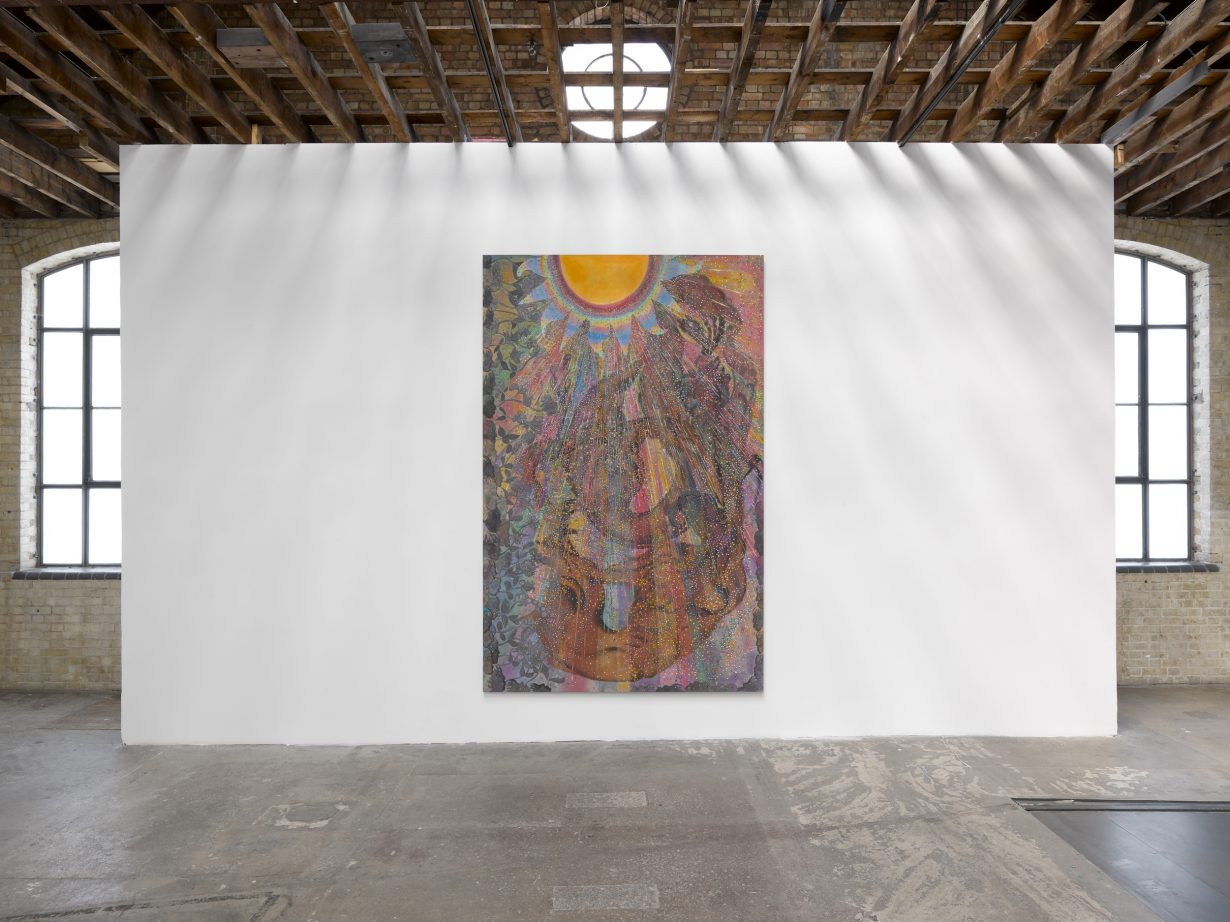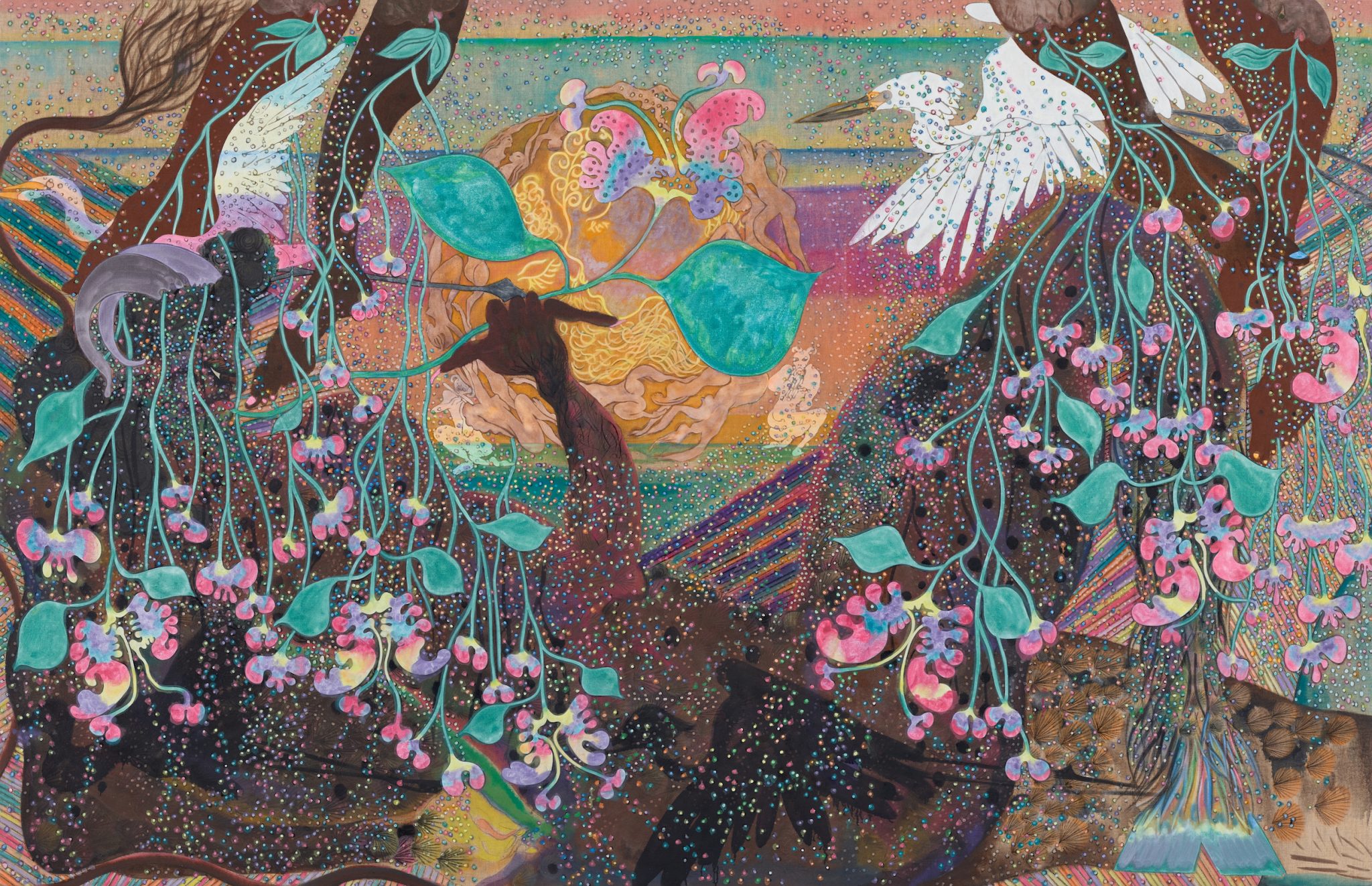A new exhibition conjures a voluptuous unearthly realm where transgression gives way to fantasy in disorientating works that dazzle the viewer
Which deity presides over the hallucinatory, outrageously fecund realm that the British artist Chris Ofili conjures in the septet of large paintings that comprises his latest solo exhibition? Given that each canvas features the figure of a satyr – all burnished horns and luxuriously shaggy fetlocks, carob-toned skin and swishing, serpentine tail – we might assume that this is the domain of Dionysus, god of wine, fertility, ritual madness and religious ecstasy. In The Swing (2020–23) – a work that borrows its composition from Jean-Honoré Fragonard’s 1767 painting of the same name – Ofili’s dandyish protagonist lounges amid lush vegetation, his lips drawing on what’s either an elaborate opium pipe or a flower stem tipped with a pulsing, vulvalike bloom. Eyes closed in narcotic or erotic rapture, he’s so deliciously woozy that he doesn’t appear to notice a naked woman swinging from a golden vine above his head.
And yet this is much more than an image of Bacchanalian excess. The title of Ofili’s show invites us to view The Swing and its companion paintings through the lens of the capital vices: lust, sloth, greed, gluttony, envy, pride and wrath. Sinfulness, we should note, is a concept that has no place in secular ethics. The Late Roman theologian Augustine of Hippo defined sin as a ‘word, deed, or desire in opposition to the eternal law of God’, and it follows that for it to exist, so too must the Christian deity. If Ofili’s satyr is subject to heavenly authority (which would surely surprise him, given he’s a creature from Graeco-Roman myth) then he needs to watch himself: any transgression risks his immortal soul.

With its voluptuous foliage and humid, unearthly light, there’s something Edenic about the satyr’s environment. Perhaps he’s really a prelapsarian innocent, or else one of the saved, swept up by divine grace to Paradise. Despite the promise of the show’s title, none of Ofili’s seven canvases focuses on a single sin. Indeed, however long we spend with these works, the satyr’s actions and intentions remain hard to parse, and thus hard to judge. Partly, this is because there’s a fine and culturally relative line between meeting the demands of our natural (God-given?) drives and indulgence in the capital vices. At precisely what point does the satyr’s pursuit of sustenance tip over into gluttony, of rest into sloth, of sex into lust? Another barrier to interpretation is Ofili’s obscuring squalls of dotted pigment, which the artist showers across the picture plane as though he were flinging great handfuls of confetti in the viewer’s face.
Atoms, cells, dust motes, pollen, raindrops, bubbles, gemstones, fireflies, bioluminescent algae and stars winking in distant galaxies – the artist’s postpointillist dots suggest all of these things and more. One of their functions in paintings such as The Great Beauty (2020–23) and The Crowning (2021–23) is to keep the eye in constant motion, revealing a pearlescent hoof here, disrupting the supple contour of a woman’s body there, shuttling our attention around the canvas as we (sinfully?) gorge ourselves on Ofili’s complex, incessant play of figuration and abstraction, surface and depth, vaporous washes of colour and clumps of thick clotted paint. There’s so much going on here, so many painterly events happening simultaneously, so many layers of art-historical reference – from William Blake to Franz Marc, Henri Matisse to Sigmar Polke – that these works are impossible to fix in the mind as single images. Instead they compel us to give ourselves over to them, to let them subsume us into the dazzling, disorienting fantasy land that they describe.

In The Pink Waterfall (2019–23), a tower of 15 disembodied heads rises up the left edge of the canvas. In their mouths they hold sinuous, heavy-petalled orchids, which stretch across the canvas and seem to double as paintbrushes, summoning the rest of the composition into being. At the centre of work, a female figure practises a yoga pose – the one-legged crab – enveloped by a tumbling, roseate stream. The spray she kicks up coalesces, on the right, into the form of the satyr, who bows his head to reverently kiss, or perhaps sip from, the uppermost orchid. With its azure petals, this bloom recalls a central symbol of the Romantic movement, the blue flower, which according to the German poet Novalis represented his longing to touch the infinite, and the exquisite pain he experienced at knowing it was beyond his reach. The Pink Waterfall is in one sense the satyr’s origin myth, and if we understand him to be Ofili’s avatar, then the painting is also a self-portrait, in which its maker depicts his own birth, or rebirth. Perhaps it’s a meditation on how his art – indeed all art – is ultimately a conduit for the unceasing creativity of nature, and whatever ineffable force set it in train. If we adopt this reading, then in bringing his lips to the blue flower the satyr exhibits not the sin of pride, but its opposite: the virtue of humility.
There are moments when the narrative elements of Ofili’s paintings are so stubbornly hermetic that they defy any satisfactory construal. I couldn’t really tell you why, say, the plume of smoke curling from a jade bowl in The Fountain (2017–23) reforms itself into a cascade of tiny spectral figures. Perhaps the point – the lesson in spiritual discipline – is to let such mysteries be. Despite its title, The Seven Deadly Sins avoids obvious images of retribution, atonement, redemption and absolution. At first glance, The Fall From Grace (2019–23) appears to show the satyr tumbling through the sky, like the rebel angel Lucifer, or the hubristic Icarus of Greek myth. Has he been cast from the celestial kingdom as punishment for transgressing divine law, or is he in fact ascending towards the blazing, numinous sun, which radiates countless egg-yolk-yellow dots, as though it were endlessly replicating itself? We’re looking at a painting – a static image – so we’ll never know. If there is a God in Ofili’s lambent, thrillingly enigmatic new works, it seems He is content to leave this sinner’s soul hanging in the balance, suspended indefinitely between heaven and earth.
The Seven Deadly Sins at Victoria Miro, London, 2 June – 29 July
